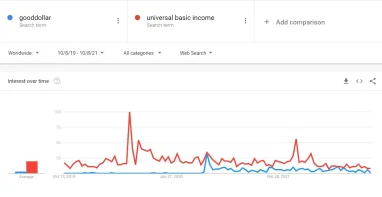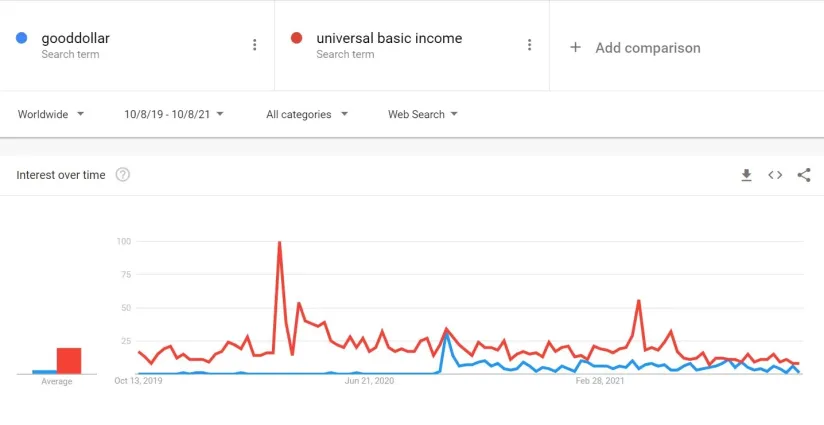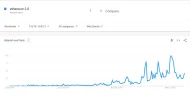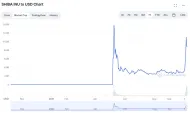Good Dollar: The Digital Universal Basic Income? Not likely in '24


Before proceeding, please read our disclaimer on investment related articles.
Good Dollar is an NGO which creates tools to distribute universal basic income (UBI) via their crypto coin called G$, by leveraging DeFi protocols on the Ethereum blockchain and Fuse.io sidechain. According to the Good Dollar website, there are currently 223,000 people in the community and 66M G$ tokens have been claimed by mid July 2021. Nonetheless, this token has not been listed on any legit exchanges such as Binance, therefore, its price cannot be tracked from a legitimate source.
The project is a noble and well supported one but currently doesn’t provide significant value to its users yet.
What is the Universal Basic Income?
Universal basic income (UBI) is a utopian idea was first proposed by the social philosopher, Thomas More, in 16th century. UBI aims to make the government provide consistent basic income to the rich and poor regardless of their work status. The distributed income will be generated via government taxes much like the Temporary Assistance for Needy Families (TANF) generated from the earned income tax credit (EIC) in the US.
Several countries around the world have tried implementing the UBI concept.
- Canada had a randomized control study in 2017 in Ontario, where the government aimed to provide basic income to 4,000 families for 3 years. The study was terminated in 2018 as a new Ontario premier came to power and claimed that the project disincentivized participants from finding work.
- In Germany, Grundeinkommen, started providing UBI to about 100 families in 2020
- In the US, the UBI idea regained its popularity during the Covid-19 pandemic. The democrat candidate, Andrew Yang, made the idea a cornerstone of his campaign. However, the idea of UBI received criticism as contenders suggested it will cost the federal government more than the generated tax, and will demotivate citizens from work.
What is the Good Dollar?
The Good Dollar is a project launched by the e-trading brokerage eToro as a corporate social responsibility (CSR) initiative. It is launched on the Ethereum blockchain in September 2020 via an open-source code on GitHub. It aims to provide a digital UBI to global communities via a decentralized cryptocurrency called G$. There is a limit supply of 2.2 trillion tokens, and as of mid July 2021, ±66M tokens have been claimed by users.
How does Good Dollar earn users coins?
Users can earn money by creating a Good Dollar wallet, signing up via their emails or social media accounts, and earn 50 tokens (about a $ cent as of July 2021) as a starting point. To sign up, users are required to create a video selfie showing their faces and identifying themselves. The wallet enables users to collect G$ by clicking a “claim” button each day on the website, which provides a number of coins based on the “Reserve Ratio”.
Reserve ratio is a number that reflects the ratio between crypto-assets locked in the GoodReserve (i.e. the staked coins) vs. the G$ out in circulation. The reserve ratio is expected to decline over time, minting more G$ coins relative to the crypto assets in the reserve.
The coin is not yet listed on any exchanges, however, users can exchange the earned tokens to Ethereum and DAI via the Meta Mask crypto wallet.
What are the types of G$ users?
There are 2 types of Good Dollar users:
Supporters
People who fund the G$ supply by staking their capital. They do not lose their principal and continue to receive interest provided by the G$ platform.
According to whitepaper, every G$ coin is collateralized in a supported cryptocurrency on a one-to-one ratio. For example, every 1 ETH, another decentralized cryptocurrency, moved into the reserve produces G$ coins in equal value.
Claimers
People who receive G$ coins. These coins are part of the interest generated by the supporter’s staked capital.
After supporters’ interest is paid out, the remaining balance of G$ coins minted from interest is distributed equally on a daily basis as basic income to claimers. The payment is divided evenly between the number of claimers that issue a claim on a given day.
Does Good Dollar have legitimate use cases?
Currently, the coin is not accepted as a payment method by major businesses. However, people have used G$ tokens for buying and selling homemade birthday cakes, vegetables from personal gardens, used iPhones, tutoring or babysitting services, etc. in a study on 500 eToro employees in Israel.
Today, users can buy and sell goods or services on the Good Dollar marketplace.
Will Good Dollar make you rich?
No and that is not the aim of the project.
Will Good Dollar provide a significant value to its users?
This is currently unlikely given the value of the currency.
Firstly, there are no red flags about the Good Dollar project:
- It is backed by a well known and profitable company as a CSR project
- G$ coin is not listed on any exchanges but that is not an obstacle to converting the coins into fiat. Users can change the G$ to ETH which is easy to trade
But it is also not showing signs of significant value generation yet. Users get a cent for signing up and the daily rewards are also insignificant (e.g. less than a cent per day) as of July 2021
In the future, one of these things need to happen for the project to provide more value to claimers:
- The capital supplied by supporters need to grow faster than the number of claimers
- The coin becomes widely used and therefore valuable. This hasn’t happened as of now:
- According to SimilarWeb, the token website doesn’t have a strong growth curve, with 2.4M global visitors in the first quarter of 2022 according to 3-4M in the fist quarter of 2021.
- If an influencer or a public figure sheds a light on it via their social media platforms or accepts it as a payment method for a business product or service, that could boost its popularity. For instance, Shiba gained substantial growth in its value when Elon Musk announced that he is interested in buying the coin.
For more on cryptocurrency
We’ve investigated different cryptocurrency projects to help people avoid scams, feel free to read our guide on how to choose a winning cryptocurrency project and avoid scammy ones. And check out our research articles about:
If you are interested in learning about the cryptocurrency market and statistics, feel free to read our article 44 Cryptocurrency Stats: History, market, adoption, users & crimes.
Finally, this is our initial opinion about Good Dollar. Feel free to share your opinion with us in the comments section:

Cem has been the principal analyst at AIMultiple since 2017. AIMultiple informs hundreds of thousands of businesses (as per similarWeb) including 60% of Fortune 500 every month.
Cem's work has been cited by leading global publications including Business Insider, Forbes, Washington Post, global firms like Deloitte, HPE, NGOs like World Economic Forum and supranational organizations like European Commission. You can see more reputable companies and media that referenced AIMultiple.
Throughout his career, Cem served as a tech consultant, tech buyer and tech entrepreneur. He advised businesses on their enterprise software, automation, cloud, AI / ML and other technology related decisions at McKinsey & Company and Altman Solon for more than a decade. He also published a McKinsey report on digitalization.
He led technology strategy and procurement of a telco while reporting to the CEO. He has also led commercial growth of deep tech company Hypatos that reached a 7 digit annual recurring revenue and a 9 digit valuation from 0 within 2 years. Cem's work in Hypatos was covered by leading technology publications like TechCrunch and Business Insider.
Cem regularly speaks at international technology conferences. He graduated from Bogazici University as a computer engineer and holds an MBA from Columbia Business School.
To stay up-to-date on B2B tech & accelerate your enterprise:
Follow on

Comments
Your email address will not be published. All fields are required.